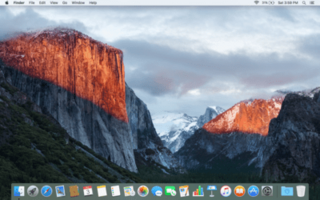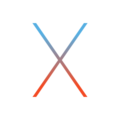OS X El Capitan facts for kids
| Version of the macOS operating system | |
 |
|

OS X El Capitan desktop
|
|
| Developer | Apple Inc. |
|---|---|
| OS family | |
| Source model | Closed, with open source components |
| General availability |
September 30, 2015 |
| Latest release | 10.11.6 (15G22010) / July 9, 2018 |
| Repository |
|
| Update method | Mac App Store |
| Platforms | x86-64 |
| Kernel type | Hybrid (XNU) |
| License | APSL and Apple EULA |
| Preceded by | OS X Yosemite |
| Succeeded by | macOS Sierra |
| Tagline | There's more to love with every click. |
| Support status | |
| Obsolete, unsupported as of October 2018. iTunes is no longer being updated, but is able to download driver updates to sync to newer devices. | |
OS X El Capitan (version 10.11) was a major update for macOS. At the time, it was called OS X. This computer operating system was made by Apple Inc. for their Macintosh computers.
El Capitan focused on making Macs work better. It improved how fast things ran, how stable the system was, and how safe it was to use. The name "El Capitan" comes from a famous rock formation in Yosemite National Park in California. This was part of Apple's plan to name their operating systems after places in California.
Apple first showed El Capitan to developers on June 8, 2015. A public test version came out on July 9, 2015. Finally, OS X El Capitan was released to everyone on September 30, 2015. It was a free update that you could get from the Mac App Store.
El Capitan was the last version of OS X that supported older Mac computers made of aluminum and Xserve servers. The next version, macOS Sierra, stopped supporting some of these older models.
Contents
What Your Mac Needs to Run El Capitan
To run OS X El Capitan, your Mac needed to meet certain requirements. If your Mac could run OS X Mountain Lion, OS X Mavericks, or OS X Yosemite, it could likely run El Capitan. However, some new features might not work on older computers. For example, a new graphics technology called Metal only worked on Macs made in 2012 or later.
Your computer needed at least 2 GB of RAM (memory) to run El Capitan. Here are some of the Macs that could use it:
- iMac (Mid 2007 or newer)
- MacBook (Aluminum, Late 2008 or newer)
- MacBook Air (Late 2008 or newer)
- MacBook Pro (Mid 2007 or newer)
- Mac Mini (Early 2009 or newer)
- Mac Pro (Early 2008 or newer)
- Xserve (Early 2009)
Some older Macs, like the iMac (Mid 2007 - Early 2008) and Mac Mini (Early 2009), originally came with only 1 GB of RAM. They needed to be upgraded to at least 2 GB of RAM to run El Capitan.
Certain features, like Handoff (which lets you start a task on one Apple device and finish it on another) and AirDrop (for sharing files between Apple devices), worked on newer Macs. These included:
- iMac (Late 2012 or newer)
- MacBook (Early 2015 or newer)
- MacBook Air (Mid 2012 or newer)
- MacBook Pro (Mid 2012 or newer)
- Mac Mini (Late 2012 or newer)
- Mac Pro (Late 2013)
The El Capitan update usually needed about 6 GB of free space on your computer's hard drive.
Cool New Features in El Capitan
OS X El Capitan brought many new features. These helped make the system more secure, faster, and easier to use. Apple said that opening PDFs was four times faster than before. Switching between apps and looking at messages in Mail was twice as fast. Apps also launched 40% faster.
A big improvement was support for Metal. This is a special technology from Apple that helps games and professional apps run much smoother and faster. El Capitan also changed the main font (text style) used on the system to "San Francisco."
Managing Your Windows
El Capitan made it easier to arrange your app windows. A new feature called "Split View" let you put two apps side-by-side in full screen. You could do this by clicking the green button at the top left of a window. This was great for multitasking, like writing a report while looking up information.
The Mission Control feature also got better. It helped you see all your open windows and switch between them easily. If you ever lost your mouse pointer on the screen, you could quickly shake your mouse or swipe your finger on the trackpad. The pointer would then get bigger so you could find it!
Better Apps
Many of the apps you use every day got updates in El Capitan.
Messages and Mail
In apps like Mail and Messages, you could now use multi-touch gestures. This meant you could swipe your fingers on your trackpad to quickly delete emails or mark conversations. The Mail app also became smarter. It could look at your emails and find information, like invitations, to automatically add them to your Calendar.
Maps
The Apple Maps app in El Capitan started showing public transit information. This meant you could see bus, train, and subway routes right in the app. This feature was available in several big cities around the world, like London, New York City, and San Francisco.
Safari
Safari, Apple's web browser, got some useful new tools. You could "pin" your favorite websites to the tab bar. This kept them open and easy to reach. If a website was playing annoying audio, Safari let you quickly find and mute the tab without having to click on it. You could also send videos from a webpage to your Apple TV using AirPlay. Safari also added support for "content blockers." These are tools that can block things like ads on websites.
Spotlight
Spotlight is your Mac's search tool. In El Capitan, it became much smarter. You could ask it questions using normal language, like "Show me pictures that I took in Yosemite National Park in July 2014." Spotlight would then find those pictures for you. It could also show you things like weather, stock prices, news, and sports scores. You could also move and resize the Spotlight search window.
Photos
The Photos app gained "editing extensions." This meant you could use editing tools from other apps right inside Photos. It made editing your pictures even more powerful.
System Integrity Protection
OS X El Capitan introduced a new security feature called System Integrity Protection (SIP). You might also hear it called "rootless." This feature protects important system files and folders from being changed by other programs, even if those programs have special permissions. Apple added SIP to make your Mac even safer from harmful software. It's turned on by default, but advanced users could turn it off if they needed to.
Images for kids
Timeline of Mac operating systems
| Timeline of Mac operating systems |
|---|
 |
See also
 In Spanish: OS X El Capitan para niños
In Spanish: OS X El Capitan para niños




